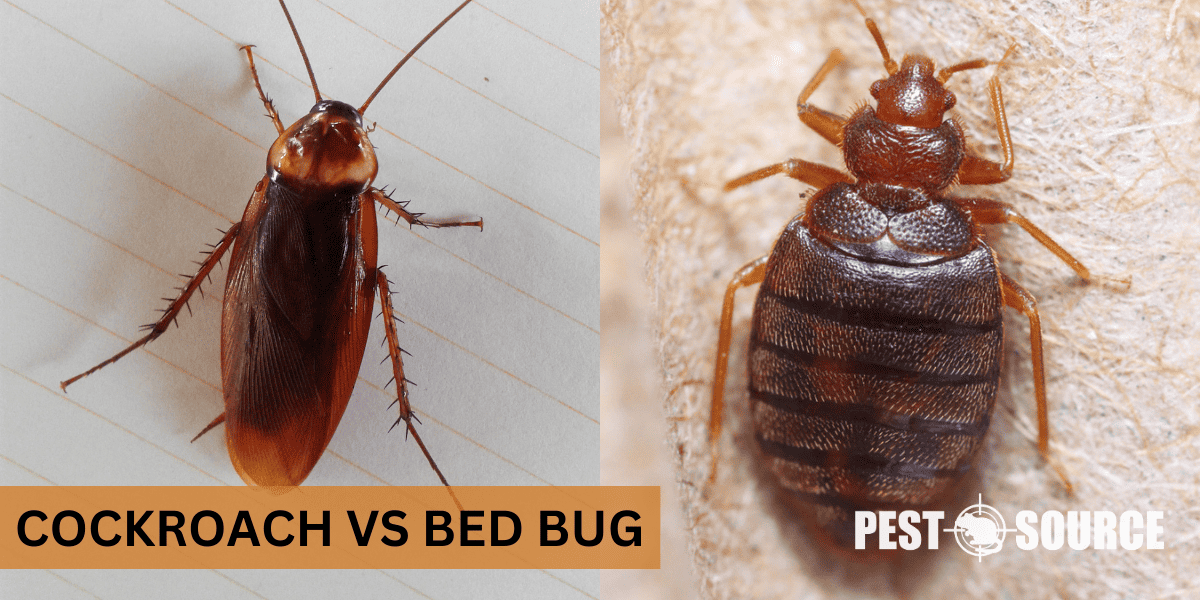While both cockroaches and bed bugs are common household pests, they have distinct differences in appearance, habits, and the threats they pose. Understanding these differences is key to effectively addressing an infestation, as outlined in this article.
POINTS
- Cockroaches and bed bugs can be distinguished by their size, shape, and color, with cockroaches generally being larger and bed bugs being smaller and flatter.
- Typical habitats for cockroaches include kitchens and bathrooms due to their need for food and moisture, while bed bugs are usually found in bedrooms near their food source, human blood.
- Signs of an infestation include seeing the pests themselves, shed skins, fecal spots, and for cockroaches, a distinct musty odor and egg cases.
- Cockroach bites are less common and larger than bed bug bites, which appear as small, red, itchy welts; both can cause allergic reactions, but bed bugs do not transmit diseases.
- Prevention of infestations involves maintaining cleanliness, sealing entry points, reducing moisture for cockroaches, and regular inspection and cleaning of sleeping areas for bed bugs, with professional pest control services recommended for severe infestations.
Identifying Cockroaches and Bed Bugs
Pest identification is the critical first step in effective pest control. Cockroaches and bed bugs are two common household pests that often cause distress and discomfort. Understanding their physical characteristics is essential for proper identification and subsequent management.
Physical Characteristics of Cockroaches and Bed Bugs
Cockroaches are typically larger than bed bugs, with a size that can range from about 0.5 inches to over 2 inches in length. They have oval-shaped bodies, long antennae, and six legs. In terms of color, most cockroaches are a reddish-brown to a dark brown.
Bed bugs, on the other hand, are smaller, about the size of an apple seed, and have flat, oval bodies. They are wingless and range in color from a light brown to a reddish-brown, becoming darker after feeding. Unlike cockroaches, bed bugs do not have long antennae or legs.
Differences in Appearance Between Baby Roaches, Cockroach Nymphs, and Bed Bugs
Baby roaches, or nymphs, can be mistaken for bed bugs due to their smaller size compared to adult cockroaches. Nymphs are typically lighter in color and will darken as they mature. They also lack wings, which can add to the confusion.
Bed bugs do not undergo a metamorphosis in the same way cockroaches do, so their nymphs look like smaller versions of the adults. Both baby roaches and bed bug nymphs shed their skin multiple times as they grow, but the shape and size of these shed skins differ.
Common Confusions and Misconceptions
It’s easy to mistake baby roaches for bed bugs because of their similar size when they are nymphs. However, baby roaches tend to be more cylindrical, while bed bugs are flatter and more elliptical. Another key difference is that bed bugs are often found clustered together, whereas baby roaches may be seen alone or in less consistent groupings.
Habitats, Behavior, and Signs of Infestation
Understanding where pests live and how they behave is crucial in identifying and controlling infestations. Both cockroaches and bed bugs have adapted to living with humans and can be found in various environments within a home.
Typical Habitats of Cockroaches and Bed Bugs
Cockroaches are often found in kitchens and bathrooms because they seek food and moisture. They can hide in cracks and crevices, behind appliances, and in drains or sewers.
Bed bugs prefer to stay close to their food source – human blood – so they are most commonly found in bedrooms. They can hide in mattresses, bed frames, headboards, and nearby furniture.
Behavioral Differences
Cockroaches are nocturnal and are more likely to be seen scurrying away when a light is turned on. They are omnivorous scavengers and can consume a variety of foods.
Bed bugs are also nocturnal but are less likely to be seen due to their elusive nature. They feed exclusively on blood and typically do so while the host is asleep.
Signs of Infestations
Signs of a cockroach infestation include seeing live or dead cockroaches, finding egg cases (oothecae), and noticing a distinct musty odor. Fecal spots from cockroaches are small and dark, resembling ground coffee or black pepper.
For bed bugs, signs include finding live or dead bugs, shed skins, and rusty or reddish stains on bed sheets or mattresses from crushed bugs. Bed bug fecal spots are also dark but will be found primarily on bedding and nearby surfaces.
Cockroaches and bed bugs can coexist in the same environment, but it is not common as they have different preferences for habitats.
By recognizing these signs and understanding the behavior of these pests, homeowners can take the first steps towards addressing an infestation. In the next part of this article, we will delve into the health implications of bites from these pests and how to manage and prevent infestations effectively.
Bites, Health Implications, and Misconceptions
When dealing with pests, it’s not just the nuisance that’s a concern, but also the health implications associated with their presence. Both cockroaches and bed bugs can bite humans and may cause different reactions and health risks.
Cockroach and Bed Bug Bites
Cockroach bites are less common than bed bug bites. They occur when cockroach populations are large, and food becomes scarce. These bites can cause irritation, swelling, and minor wound infections. They are typically larger than bed bug bites and can be isolated or in clusters.
Bed bug bites, conversely, are a common sign of an infestation. They often appear as small, red, itchy welts in a line or cluster, usually on exposed areas of the skin while sleeping. Unlike cockroach bites, bed bug bites have a central, raised area and occur more frequently.
Health Risks and Allergic Reactions
Both pests can cause allergic reactions. Cockroach allergens are known to trigger asthma attacks, especially in children. The risk increases with the level of infestation and the duration of exposure.
Bed bugs, while not known to transmit diseases, can cause secondary infections from scratching the bites. The psychological effects, such as anxiety and sleep disturbances, can also significantly impact well-being.
Misconceptions About Bites and Health Risks
One common misconception is that cockroaches and bed bugs only bite dirty or unsanitary people. In reality, cleanliness is not a factor; these pests are attracted to warmth, carbon dioxide, and, in the case of cockroaches, any available food source.
Another myth is that bed bugs can spread diseases. To date, there is no evidence to suggest that bed bugs are vectors for disease transmission, although research is ongoing.
Do Baby Roaches Bite?
Baby roaches can bite, but it is extremely rare. If a bite occurs, it would be indistinguishable from an adult cockroach bite and would require the same treatment: cleaning the area and applying an antiseptic.
Prevention and Control Strategies
Preventing an infestation is always more desirable than dealing with one. Here are some strategies to keep these pests at bay.
Preventing Infestations
To prevent cockroach infestations:
- Keep your home clean, particularly the kitchen and bathroom.
- Store food in sealed containers and dispose of garbage regularly.
- Seal cracks and crevices to eliminate entry points and hiding places.
- Fix leaky pipes and faucets to reduce moisture.
To prevent bed bug infestations:
- Regularly inspect and vacuum your sleeping areas.
- Use protective covers for mattresses and box springs.
- Be cautious when bringing second-hand furniture into your home.
- When traveling, check hotel rooms for signs of bed bugs and keep luggage off the floor.
Control Methods
For cockroaches:
- Use baits, traps, and insecticides specifically designed for cockroaches.
- Consider professional pest control services for severe infestations.
For bed bugs:
- Wash and heat-dry bed linens and clothing that may be infested.
- Use targeted insecticides, including sprays and powders designed for bed bugs.
- Professional heat treatments can be effective but may require a pest control expert.
Maintaining a Pest-Free Environment
Regular home maintenance and vigilance are key to avoiding infestations. Regularly inspect your home for signs of pests, keep clutter to a minimum, and address any pest sightings immediately to prevent them from becoming a larger issue.
By following these prevention and control strategies, you can significantly reduce the risk of an infestation and maintain a healthy, pest-free home. Remember, the key to effective pest control is early detection, proper identification, and consistent action.
Cockroach vs. Beetle
Cockroaches and beetles differ significantly in their physical characteristics and behaviors. Beetles are characterized by their hard, shell-like wing covers and a wide variety of shapes and sizes. They have a more diverse range of habitats and diets, with many species being beneficial to the environment through pollination, decomposition, or as natural pest controllers. Unlike cockroaches, most beetles are not considered household pests.



